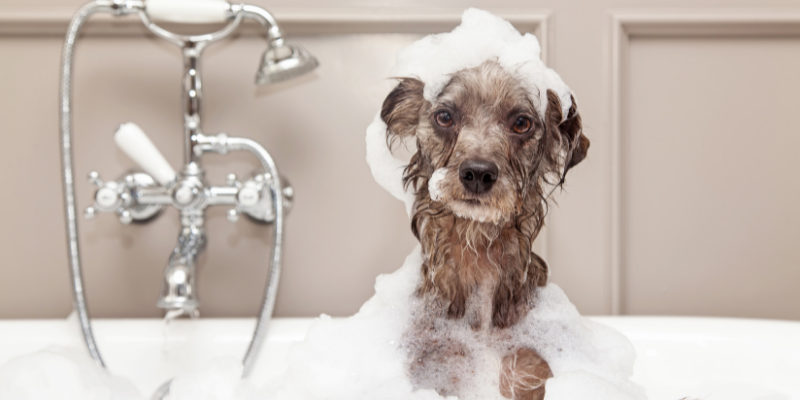Dog Care Guide
How to Take Better Care of Your Dog
Dog care involves looking after your pup in all capacities. Just like us humans, dogs need well-rounded care to live their best life. Feeding your dog right is just the start! They also need proper exercise, regular vet’s visits, and even occasional indulgence with toys and treats.

Every Dog’s Basic Needs
Your dog will survive on just food and water. But those are just the tip of the iceberg. In order for your dog to live healthily and happily, make sure they’re getting enough food and water, have enough space, get the right amount of exercise, and are regularly groomed.

Food and Water
Giving your dog cheap kibble twice a day isn’t enough. You need to feed your dog the RIGHT food for them to be healthy, as well as a constant supply of fresh water.
Why It’s Important to Feed Your Dog High-Quality Food
Not all dog food is created equal. One of the best dog care tips we can give you is to be selective about your dog’s food!
Feeding your dog a low-quality dog food can contribute to health problems and increase the risk of disease. On the other hand, a high-quality dog food can build your dog’s immune system and give them the energy they need for their daily life.
5 Tips for Properly Feeding Dogs
1) Check Their Calorie Intake
The easiest way to do this is to check the guidelines on the back of your kibble packet. Alternatively, use a calorie calculator like this one to find out how much your dog needs to eat.
Consider your dog’s physique too. If your pup is chunky, they need fewer calories than they’re eating now. If they’re scrawny, they need more.
2) Choose the Right Nutrition for Their Breed
Typically, small breeds need a higher fat count than large breeds. Working dogs need more protein than non-working dogs. Dogs with luscious fur would do well with a food containing high levels of Omega fatty acids.
You’ll need to consider your dog’s breed (and do some research) in order to choose a food with adequate protein, fat, and supplements.
3) Decide What Type of Food to Use
Dry dog food, or kibble, contains good levels of proteins and fats, usually contain supplements, and also help improve dental health as your dog crunches them.
Wet or canned food usually is not complete and balanced, contains more moisture than nutrition, and is usually rather high in calories. Fresh or raw dog food are minimally processed and high in nutrients.
4) Figure Out the Proper Time to Feed Them
Two meals a day should be the minimum. Dogs who are prone to bloat or tend to overeat should be fed smaller meals three or four times a day.
Once you’ve figured out how often to feed your dog, remember to split their total daily calorie count between their meals.
5) Feed Them Healthy, Low-Calorie Treats
Treats can make or break your dog’s diet. We highly recommend NOT feeding your dog human food. Instead, buy healthy dog treats that are high in fat or protein.
Make sure you count your dog’s treats in their daily calorie count so you don’t end up overfeeding them accidentally.

Space
Some dogs will do great in an apartment. Others need space to run. Consider your dog’s breed and activity level to figure out what works best for them.
Indoors or Outdoors?
A dog needs space. That said, some dogs (like Great Danes, surprisingly) do quite well in a tighter apartment space. But even indoor dogs still need time outdoors to stretch their legs and get fresh air. If your dog lives mainly indoors, take extra care to give them enough outdoor time.
5 Tips for Dog-Proofing Your House
1) Keep Anything Edible Out of Reach
Dogs don’t just chew on real food items. Anything that smells interesting to them is worth a lick or chew. You’ll need to take extra care to place these things well out of your dog’s reach, as most of them are toxic to pets. They include:
- Medication
- Cosmetics
- Lotions
- Cleaning products
- Food
- Spices
- Fire starter sticks
- Mothballs
- Chemical toxins
2) Keep Loose/Hanging Wires Out of the Way
Dogs can chew on, trip over, or get caught up in loose wires. If you have lamp cables, internet or phone wires, or any other cables that aren’t safely out of the way, address it as soon as possible.
You can tape them up into a bundle using insulation tape or buy cable ties or a cable sleeve.
3) Keep Sharp/Dangerous Items Out of Reach
If it can hurt your dog’s mouth, lift it out of reach. Put some thought into this – you may not realize all the things that can be dangerous to your dog. Remove things like:
- Clothes hangers
- Tools
- Nuts, bolts, and screws
- Pins and needles
- Small plastic items
4) Block Spaces Your Pet Could Crawl Into
Keep your dog from climbing or squeezing into small spaces where they may get stuck or injured. Block up any holes in walls or under decks, as well as openings in fences where they could escape.
5) Check Your Plants
Some of your indoor plants may be toxic to pets! Double check all your plants. If you find toxic ones, either move them to a spot your dog can’t reach them (and they won’t drop seeds or leaves), or get rid of them entirely.
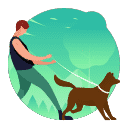
Exercise
Whether your dog lives indoors or outdoors, they need dedicated exercise time. This will require some effort on your part, but it has a huge impact on your dog’s health and happiness.
The Benefits of Regular Exercise for Dogs
Not all dogs require a huge amount of physical activity. But they all need some time outdoors, in the fresh air, getting those muscles moving. A simple walk at the park or cycling together with your dog will do wonders! Exercising regularly will:
- Improve your dog’s cardiovascular system
- Help your pup build more muscle
- Improve your pet’s mood
- Provide mental stimulation
- Give them something to look forward to
- Boost the immune system
3 Tips for Proper Dog Exercise
1) Find Out How Much Physical Activity Your Dog Needs
Your dog’s exercising needs might depend on their breed, their general physical condition, and their weight. It’s advisable to do some research. For example, a Border Collie needs a decent, energetic run every day, while a Great Pyrenees may be quite content with a chilled out trot around the neighborhood.
2) Introduce Various Activities
Your dog may be perfectly happy with a run every day, but it’s a great idea to vary the exercises so you (and your dog) don’t get bored. Try going for a run, wrestling with your pup, playing fetch, or even swimming.
3) Consistency is Key
Make sure your dog gets consistent exercise. There’s no point in doing a serious walk/run once a week, because it’s not enough to reap the benefits. Some form of physical activity daily is essential. This could be a short run, some play fighting, or even just throwing the ball for a while. As long as some form of physical activity is happening every day!

Grooming
Grooming isn’t just for looks. It’s an essential part of keeping your dog comfortable, as well as preventing skin and coat conditions that can arise due to ungroomed fur.
Why It’s Important to Keep Your Dog Groomed
Letting your dog’s coat grow wild can actually lead to discomfort and health conditions. Unkempt fur can harbor bacteria and fungi, leading to allergic reactions and dry, itching skin. If your dog has a lot of fur, the heaviness of matted fur can also pull on the skin, causing pain.
Dog Grooming Kit to Have at Home
You won’t necessarily need every type of brush in your home dog grooming kit. But here’s what we do recommend:
- Brush: We recommend a slicker brush for removing tangles and mats and a pin/bristle brush for getting that shine.
- Dematting Tool: Dogs with a double coat will need a tool to remove tangles in the undercoat. A rake, deshedding tool, or dematting tool will do the job.
- Nail Clippers: Dogs’ nails grow fast! Get your dog used to having their nails cut very early. Take care to do it gently and without hurting your pup.
- Hair Clippers: Do not use human hair clippers! Invest in a good set of dog clippers, preferably with ceramic blade (although steel is acceptable), and interchangeable blades.
- Shampoo & Conditioner: Obviously you won’t need this every time you groom your dog. But it’s essential for those times when you do bathe your pup. Choose from a general formula, anti-itch, or even special medicated shampoo.
- Fluffy Towel: Drying your dog properly is critical, especially if they have a double coat! Once again, this will only be used every other month.
- Toothbrush & Toothpaste: Keeping your dog healthy extends to their dental health. Regular tooth brushing can help keep bacteria away.
- Liquid Ear Cleaner: Dog’s ears are prone to infection. Choose a general ear cleaner and do a routine clean every time you groom to stay on top of potential issues.
- Cotton Balls: These are gentle on the skin and useful for cleaning your dog’s ears and wiping their eyes and face.
- Treats: Not all dogs will love being groomed! If they know there’s a treat waiting for them, they may be more comfortable to let you groom them. Remember, positive reinforcement is key!
5 Dog Grooming Tips
1) Understand Your Dog’s Coat
Some dogs have double coats, others have single coats. Mixed breeds or designer dogs could inherit one or the other depending on their parent breed.
Knowing which one your dog has will help you understand how to groom them effectively and which tools you’ll need.
2) Get in a Grooming Habit
At least once a week is a necessity. Get your dog into a habit early, so they know to expect a good weekly grooming. If you can, give them a quick brush every evening to maintain the smoothness of their coat. Whichever time period you pick (daily, weekly, bi-weekly), make sure you can stick to it.
3) Start with The Undercoat
Start with the undermost layer of fur. This is closest to the skin, and the most important to remove knots and mats from. It may also take the longest, as dead skin and loose hair can become trapped in it easily. Only once it’s smooth and tangle-free should you move onto the top coat.
4) Only Bathe Your Dog Every Few Months
You only need to give your dog a bath every second month, unless they become muddy or smelly. Bathing too often can reduce the amount of natural oils in the skin and fur, leading to dry skin and brittle hair.
5) Invest in High-Quality Grooming Tools
We advise never using a human hair clipper on a dog’s coat! Invest in decent dog grooming tools to make the experience less frustrating for you and less painful for your pup.
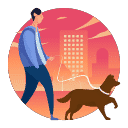
Training
Dog care tips aren’t just about food and health! They extend to training too. A well-trained dog is not only easier to handle for humans, but teaching your dog to obey commands can also be an important safety factor.
The Importance of Training Your Dogs
An unruly dog can be frustrating, as well as dangerous to both you, other people, and other animals nearby. Just a little bit of training can help you to better control your dog, reducing frustration and increasing the safety of all those around.
Teaching your dog commands or tricks can also be a valuable bonding experience between pup parent and pooch!
5 Dog Training Tips
1) Start As Early As Possible
Although older dogs can still learn if given the right motivation, it’s far easier to teach puppies new habits. Start training your dog as early as possible. If, for example, you’ve adopted an older dog, don’t assume they can’t be trained! It will just take some patience and plenty of positive reinforcement.
2) Use a Dog Crate
Crate training is underrated. It’s a great way to give your dog his own space in the house, soothes anxiety and teaches them to associate the crate with positive things, which can help when you need to travel. Make sure you choose the right size crate for your dog and kit it out with an appropriate tray if necessary.
3) Use Positive Reinforcement
Anger, negativity, or punishment is never the best training method. While it may work, positive reinforcement will always work better. If your dog learns to associate actions with receiving treats, love, or praise, they’ll be more inclined to do them. Try these low-calorie training treats to avoid overfeeding your dog!
4) Make It Fun
If you can make your dog think he’s playing while he’s actually learning, then you’ve hit gold! Your dog is more likely to learn quickly if he’s having fun while he’s doing it. This extends to your attitude about training! Be happy and let him know that you’re enjoying spending time with him, and your dog may just learn faster.
5) Make Training Part of Everyday Life
Although you will need to set aside specific time to train your dog, incorporating it into everyday life is the best way to get it to stick. Teach your dog to sit while waiting for his dinner. Train your dog not to jump on visitors, and reward them when they get it right. There are many opportunities to reinforce training every day.
Dog Health Care
You can follow these dog care tips to a T, but there’ll still come a time that your dog needs a veterinarian visit or special health care. Keep your dog as healthy as possible by paying attention to these areas of their health.
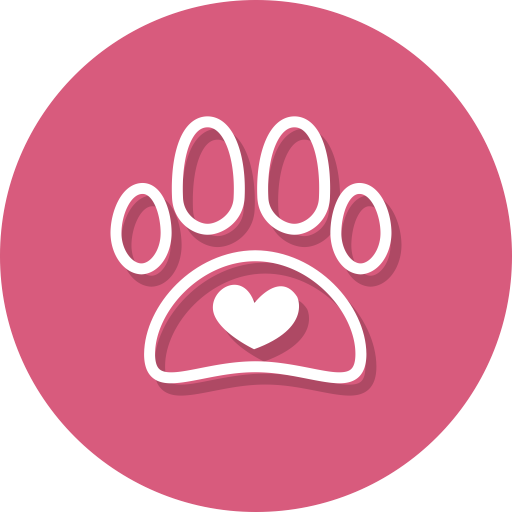
Areas That Need Special Attention
Oral Care
Dental problems can cause your dog extreme pain and discomfort, as well as lead to them not wanting to eat. To keep their oral health up, it’s advisable to feed them a dry kibble which helps to prevent tartar buildup on their teeth. We also recommend brushing your dog’s teeth regularly, and perhaps using a breath freshener spray too.
Paw Care
If your dog’s paws get hurt, they’ll be out of action for a while. Keep their paws safe by making sure they have shady spots if they live outdoors, as well as keeping dangerous objects out of their way (for example, glass, plastic, or wooden things that can break or splinter, leading to injury).
Yeast infections are also common in the paws. This is characterized by a “Frito” smell on the paws, and can be extremely itchy. If you notice your dog chewing on his paws, get it looked at by a veterinarian!
Joint Care
Both large breed and small breed dogs need joint care, especially if they’re very energetic. Choosing a food containing glucosamine is a good step towards protecting their joints.
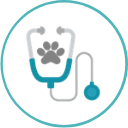
The Importance of Regular Visits to the Vet
We recommend that you take your dog to the veterinarian for regular checkups, even if there’s no real cause for concern. Just as we humans would go for a checkup to rule out underlying conditions, your dog’s vet can make sure they’re healthy and happy, and have no diseases or potential weak spots that could lead to injury.
If there is an underlying health problem, getting an early diagnosis can give your dog the best chance possible of getting healthy again or managing their condition.

Dog Insurance
Dog insurance is an excellent way to keep your dog covered for sudden and unexpected vet’s visits. Accidents happen, and bringing your dog back to health can cost hundreds, if not thousands of dollars. Some can lead to long-term costs, like lifetime medication.
It can cost anywhere from $20 to $50, depending on your location and your dog’s age, health, and breed.
Benefits of Having Dog Insurance
It may seem like an extra expense, but investing in dog insurance can be extremely beneficial. It prevents you from digging into your savings in the event of an emergency, and it offers you peace of mind that your dog will always be covered. Here are some insurance companies to consider:
- Hartville Pet Insurance (USA)
- 24 Pet Watch (USA)
- Figo Pet Insurance (USA)
- GEICO (USA)
- Pet Assure (USA)
- Waggel Pet Insurance (UK)
- Pet Insurance (UK)
- Healthy Pets (UK)
- Petplan (UK)
7 Tips for Taking Care of Your Dog’s Health
1) Go for Regular Checkups
You can give your dog a head start by going for regular checkups even if they seem perfectly healthy. Your dog may have an underlying condition that only the veterinarian can pick up. You can deal with health issues as soon as possible, and prevent them from becoming worse.
2) Use Supplements
Some dog breeds are prone to skin and coat conditions, while others struggle with joint problems. You can keep your dog as healthy as possible by supplementing with nutrients that can help these conditions. For example, if your dog is susceptible to joint dysplasia, glucosamine can keep their joints strong. Senior dogs can benefit from L-carnitine for energy metabolism.
3) Vaccinate
Although dog medical care is improving, certain diseases are still extremely dangerous. Get your dog vaccinated against rabies, distemper, and parvovirus at the very least.
4) Spay or Neuter
Spaying or neutering your dog can reduce the chances of them getting certain cancers. Females won’t be at risk of unwanted pregnancies, and males become significantly less aggressive.
It also eliminates the chance of your intact dog wandering the streets looking for other dogs and potentially getting lost or running into the road.
5) Keep Their Weight in Check
Overweight dogs are at risk of developing diabetes, heart problems, gastrointestinal issues, and joint problems. Take your dog for a run every day to make sure they’re getting enough exercise, and feed them the right amount of a high-quality food. Your veterinarian may suggest a weight management food.
6) Pay Attention!
Your dog can’t tell you when something is wrong. It’s up to you to pay attention and notice if their behavior has changed or if they’re displaying signs of discomfort or pain. Take some time to learn your dog’s habits so you can pick up if anything changes.
7) Give Them Love
Your pet can eat the best food and get all the exercise they need, but all they really want is your love! Take care of your dog’s emotional needs as well as physical. Give your dog plenty of love, cuddles, and affection so he knows he is loved.

Special Care
Some dogs will need extra special care due to physical changes in their body. In these cases, it’s important to do your research and make sure you give your dog what they need during these times.
Areas That Need Special Attention
These dogs may need an extra visit to the vet every few weeks. Keep an eye on their general health and get in touch with the vet if there’s any cause for concern, however small.
Spayed/Neutered Dogs
Hormonal changes can lead to metabolic changes. Your dog will eat less after spaying/neutering than they did before. It’s essential to reassess their calorie count and activity level and adjust how much you’re feeding them to prevent them from becoming overweight. For the first few weeks after the operation, they’ll also need some extra love!
Senior Dog Care
As dogs age, their metabolisms also slow down. This, and less activity, means they’ll need less energy. You’ll need to choose a kibble with a lower fat count but keep the protein high to maintain muscle mass. Supplement with glucosamine, L-carnitine, and DHA (for strong eyesight and mind power).
Pregnant Dogs
A pregnant dog is eating for more than one! You’ll most likely need to change her food. Choose something with a fat count of 20% or more and a protein count of 30% or higher. It also needs to contain DHA, which is an essential nutrient for puppies.
4 Tips for Dogs Who Need Special Care
1) Cater to Their Needs
Depending on the dog and their condition, every dog will need slightly different care. Take note of your particular dog and what they need in their condition.
Do your research! Some dogs will need more food, others will need less. Some will need meds, and others just need plenty of love. Cater for your dog.
2) Reassess Often
Keep a constant watch on how your dog is doing and if they’re getting enough food, medicine, rest, or whatever else they need.
We recommend reassessing weekly. Consider your dog’s weight, the condition of their skin and fur, and general happiness.
3) Get an Expert Opinion
If you’re worried, take your dog to the vet. An expert opinion can help immensely to give you insight into your dog’s condition and set your mind at ease about their health.
4) Be Patient
All dogs deserve patience, but when you have to suddenly spend twice as much time looking after your pup, it can be easy to become frustrated. Remember, your dog relies on you to stay healthy. When they’re not feeling the best, they need your patience and love even more.

Emergency Dog Care
One in three dogs will require emergency care every year! We pray it won’t be our own dogs, but accidents can happen. Being aware of emergency care is the first step towards getting your dog through these situations.
What Qualifies As An Emergency?
Although it depends on your dog, the following are considered to be emergencies that need immediate medical intervention:
- GVD/Bloating
- Insect bites and stings
- Seizures
- Heatstroke
- Choking
- Severe bleeding
- Exposure to toxins
- Being hit by a vehicle
- Falls from higher than 4 feet
3 Tips for Emergency Care
1) Learn Pet First Aid
Invest in a dog first aid kit and learn some pet first aid! You’re likely to be the first person in contact with your ill or injured dog. The more you can do to help, the better their chance of surviving and healing.
2) Don’t Wait
Take your dog to the vet as soon as possible. Emergency conditions need urgent medical care, and every minute they don’t get to a vet, more damage is being done. It’s better to take your dog to the vet and find out there’s no emergency than dismiss it and find out later when it’s too late.
3) Stay Calm
Your dog picks up on your moods and emotions. Staying calm will help your pup to stay calm too! Comfort and console your dog, and stay near to them so they know their mom or dad is nearby.

Wrapping Up
Your beloved dog can’t tell you when he or she is feeling sad, sore, sick, or upset about something. You are your dog’s only hope when it comes to keeping them healthy and happy! You may have heard the term “advocating for your dog”. That’s what it means – being your dog’s eyes, ears, and voice when it comes to caring for them.
Caring for your dog means taking the time to get to know your pup well. Learn their body language and how to tell when something is wrong. Understand what situations stress them out, and do your best to avoid those.
In other words, treat your dog like you’d treat your child, and you’ll be advocating for them! They deserve it, after all – they spend their lives trying to please us. Don’t we owe it to them to take the best care of them we possibly can?
